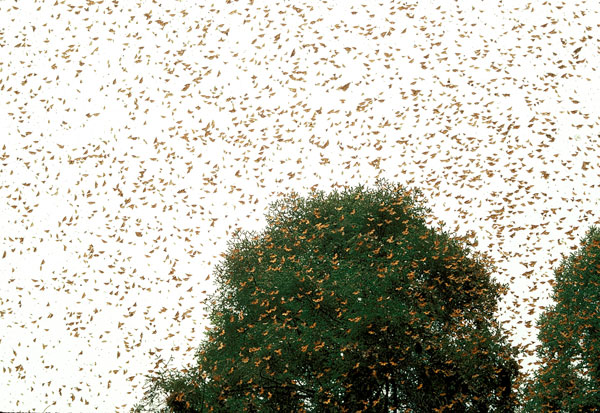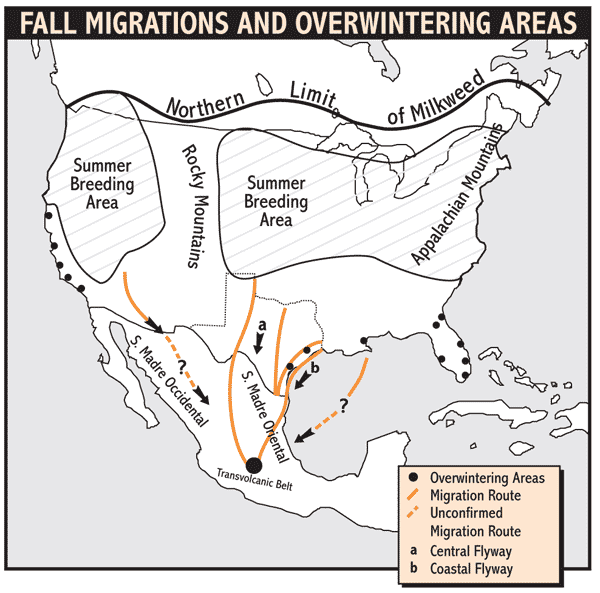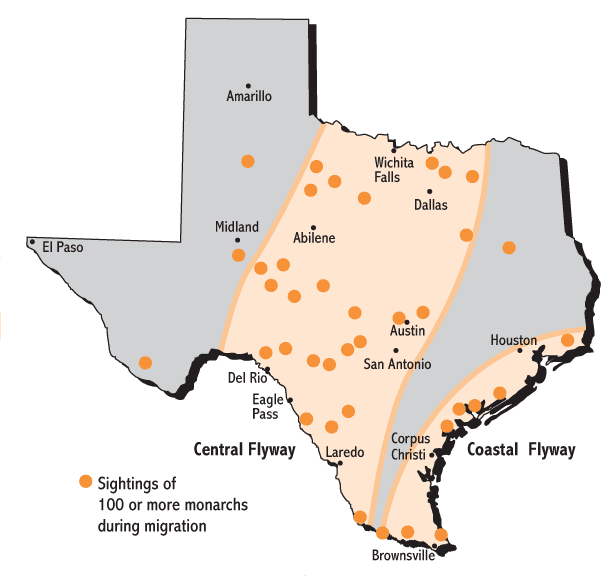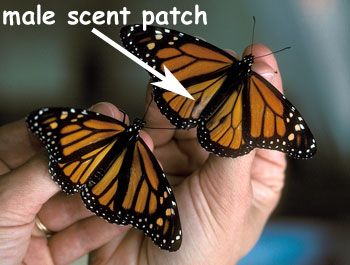Student Research Page
Mysterious Monarchs
If you don't have a copy of the TPW magazine, you may print a copy of Mysterious Monarchs (pdf).
Migration

Wow, look at all those Monarch butterflies! These Monarchs are migrating to another location.
Monarch Migration Flyways

Every year, Monarchs migrate across North America. Paths that migrating birds or butterflies follow are called "flyways" meaning the way that they follow as they fly. The monarchs have their own flyways. The North American Monarch breeding population is split into eastern and western populations divided by the Rocky Mountains. By far the larger of the two populations is the eastern population. Most of these butterflies fly south though Texas' Central Flyway on the way to their wintering grounds in central Mexico. In addition to Texas' two flyways, some Monarchs fly to Mexico from the west or across the Gulf of Mexico. Besides central Mexico, other smaller overwintering colonies occur on the coasts of California, Florida and Texas. Monarchs breed as far north in the Summer as Milkweed grows in southern Canada.

Here's an example of where Monarchs migrated across Texas. The paths can change slightly each year. The dots represent reports send in from citizens who are part of Monarch Watch. Do you live near one of the flyways?
Keeping It Wild!
Learn About Monarchs!

Look closely to see the difference between a male and female Monarch!
Monarchs are the only butterflies known to make long distance migrations. They are members of a tropical family that cannot survive cold winters. North American monarchs migrate south in the fall to California, Mexico or Florida. On the way north in the spring they lay eggs. It's the young produced by those and the next generation's eggs that return all the way north and start south again.
Monarchs lay their eggs on milkweed plants. Female monarchs can lay between 400 and 600 eggs. Their caterpillars absorb the poisons produced by the plant and become poisonous themselves. Birds that try to eat monarchs or their caterpillars become ill. They quickly learn that monarchs are not good to eat. Other butterflies, such as Queens and Viceroys, copy the colors of monarchs so that birds won't eat them either.
Adults feed on flower nectar. Caterpillars feed on plant leaves, preferring milkweeds and dogbanes. Monarchs must eat a lot to store fat to use as an energy source during cold weather.
Adult monarch butterflies are orange above with black veins and white spotted wing borders. Males have a black scent patch on a vein across the middle of the hind wing.
Monarchs return by the tens or hundreds of thousands to the same groves of trees each winter. They are sluggish during the winter and feed only on warm days. Humans are trying to protect these important places by creating butterfly preserves. Researchers study monarch migration by tagging individual butterflies to see where, how far and how fast they travel.
Habitat
Monarchs occur wherever milkweeds grow. Monarchs are found all over Texas, the U.S., southern Canada and Mexico to central America. There are also breeding populations in Hawaii and Australia.
Can you spot the matching monarchs?
Plant a butterfly garden!
Learn More
Learn About Texas Insects Activity Book
Journey North: Track the monarch's journey. Watch for monarchs that are flying, resting and refueling.
Science Museum of Minnesota
Monarch Butterly Site: Information about gardening, rearing, and student activities
Life Cycle of the Monarch (Chicago Nature Museum YouTube video)

